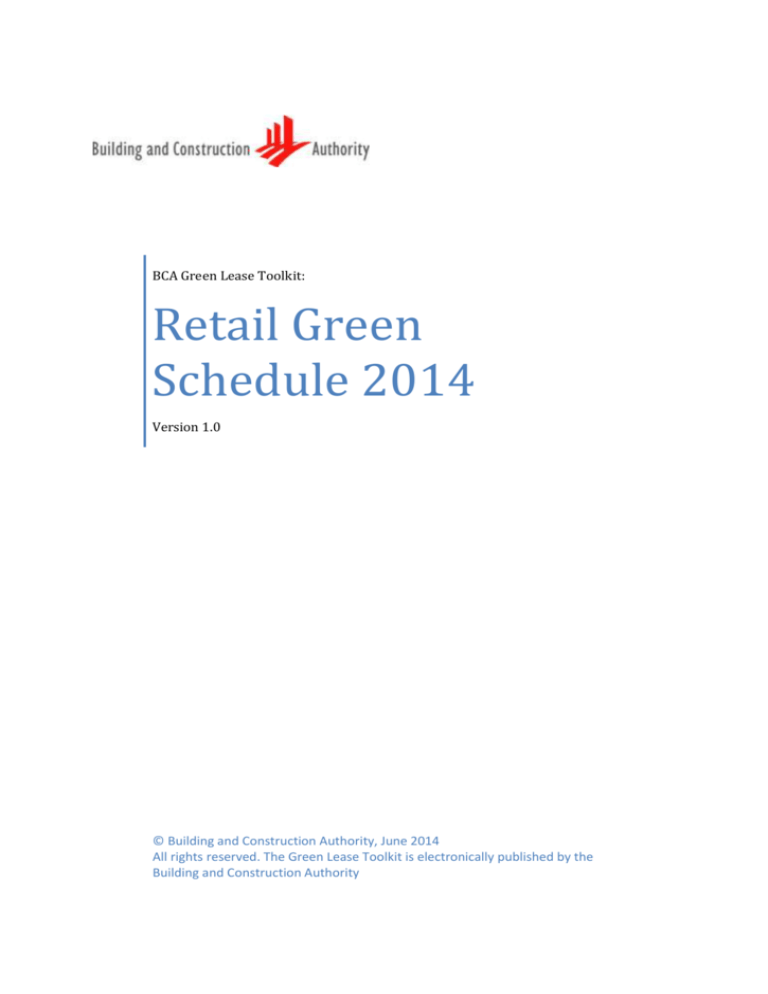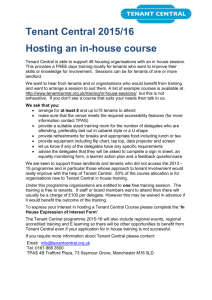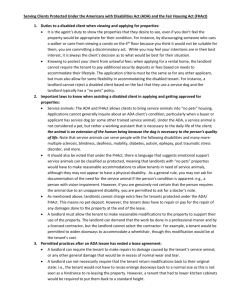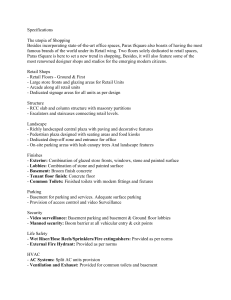
BCA Green Lease Toolkit:
Retail Green
Schedule 2014
Version 1.0
© Building and Construction Authority, June 2014
All rights reserved. The Green Lease Toolkit is electronically published by the
Building and Construction Authority
RETAIL GREEN SCHEDULE 2014
Contents
Introduction
Page 2
General
Page 3
Section A: Suggested Minimum Standards (Landlord)
Page 3
Section B: Additional Standards (Landlord)
Page 5
Section C: Suggested Minimum Standards (Tenant)
Page 9
Section D: Additional Standards (Tenant)
Page 11
Section E: Environmental Assessment and Reporting
Page 14
Page: 1 of 14
RETAIL GREEN SCHEDULE 2014
Introduction:
The BCA have created a green lease toolkit to aid landlords and tenants to work together to improve
their environmental performance over the life of the building in which they manage or occupy.
The environmentally friendly leasing arrangement or ‘Green Lease’ in short, is an agreement
between landlord and tenant which sets out environmental objectives on how the building is to be
improved, managed and/or occupied in a sustainable manner. This both yields cost savings in
energy and water which can be shared among parties and provides a better indoor retail
environment.
The Green Lease acknowledges the possible synergies in cooperation between building owners and
tenants (and any relevant service providers and contractors). It addresses traditional structural
barriers to implementation, such as split incentives and interests between building owners and
tenants, by ensuring that the parties with influence over key aspects of environmental performance
obtain some benefit from implementing the improvements. For example, by installing energy
efficient lighting that generate less heat, a landlord can benefit from a reduced overall airconditioning energy consumption while a tenant can benefit from the reduced energy bill for lighting
usage.
The Green Lease improves transparency and accountability through providing an agreement
between both landlord and tenant ensuring that the parties identify and address problems promptly
and efficiently together.
The Retail Green Schedule provides a list of standard clauses that contain specific provisions for
monitoring and improving energy efficiency, water efficiency, outdoor and indoor air quality,
sustainable material and waste management, through a target based approach applicable to retail
buildings and tenants. These standard provisions are fully editable to suit your building or individual
tenant’s context. The schedule can form part of a memorandum of understanding, or an
arrangement between landlord and tenant to adopt procedures to ensure the building operates to
the agreed level. Or be an enforceable schedule that forms a part of the lease agreement, with
penalties for noncompliance.
The Green Schedule should be read in conjunction with the relevant BCA Green Mark criteria.
BCA Green Mark, and BCA Green Mark logo © Building and Construction Authority.
Users are free to use and adapt the Green Schedule clauses as required at their own risk. BCA shall not be liable for any
damage or loss of any kind caused as a result (direct or indirect) of the use of the Green Schedule clauses, including but not
limited to any damage or loss suffered as a result of reliance on the Green Schedule clauses.
Users should seek relevant professional and legal advice before including the clauses or the schedule within their lease, or
tenancy agreements.
Page: 2 of 14
RETAIL GREEN SCHEDULE 2014
Green Schedule for Retail Buildings:
This schedule is provided for Landlords and tenants to edit the performance levels and clauses
and content as they see fit based on their individual contexts. Where blue highlighting occurs in
the clause this is for the user to edit or insert their own values. Parties are encouraged to adopt
as many clauses as possible to substantially improve the environmental performance of the
building in a collaborative manner. In addition to this guide many international guidance notes
and case studies can be found in the accompanying green lease guide. This schedule is primarily
aimed at the larger tenants of a retail building, however can be applied to SME tenants in
addition.
General:
The landlord and tenant(s) are committed to manage operate and occupy the building and premises
to promote environmental sustainability, through energy efficiency improvements, positive
behavioural changes and healthy practices. This schedule forms a <memorandum of understanding /
mutual performance and disclosure agreement / part of the lease agreement with penalties for nonconformity*1 >
*1Select one. Refer to the Green Lease Toolkit guide for more details
Section A: Suggested Minimum Standards (Landlord)
This section details the key ingredients that should be considered as a part of the green lease
adoption. Performance requirements should be tailored for the building context and reached
collaboratively with the relevant stakeholders. Reference should be paid to ‘Section E’ of this
schedule. There will need to be a form of Building Management committee – however the extent of
this will vary dependant on building and tenant mix.
A1 Certification:
I.
The Tenant agrees that the Landlord shall be entitled to operate, manage and maintain the
Building so as at least the BCA Green Mark <Insert Rating> for Non Residential Buildings or
the future applicable BCA Green Mark certification standard. The landlord commits to
maintain this level of certification <during the entire lease period / certification period /
other please specify>
II.
To <achieve / maintain> the Public Utilities Board’s (PUB) Water Efficient Building
Certification <Basic/Silver/Gold>* The landlord commits to maintain this level of certification
<during the entire lease period / certification period / other please specify>
III.
[suggested] The retail building <operator or landlord> to be ISO 14001 or ISO 50001 and SS
577 Certified
Page: 3 of 14
RETAIL GREEN SCHEDULE 2014
A2 Management of Energy Use
I.
Monitoring and reporting of base building consumption with targets set for continuous
improvement < x kWh*2 or x % over insert period >. Building reporting to include the
building’s environmental performance, building rating system achievements and progress on
other targets set.
*2The kWh can be actual savings which are captured by the electricity consumption tracking of the
entire building, or via a demonstrated savings approach where the retail activities are expanding or
intensifying. Demonstrated savings are calculated savings based on equipment efficiency
improvements.
II.
Provide tools to support the tenants to calculate their electricity consumption in the design
using the ‘services calculator*3. This shall include (but not limited to) lighting load, and the
non-saleable items receptacle (plug) load.
*3 BCA will aim to provide a simple spreadsheet based calculator for industry use. It is encouraged that
the landlord build upon this simple calculator to improve the usability and apply to their tenants needs
III.
Installation of building metering to separate and monitor the building energy usage such as
lighting, receptacle (plug) loads and ACMV systems.
IV.
All the landlords light fittings shall be energy efficient; there shall be no use of halogen,
incandescent or neon lighting. All ballasts*4 are to be high frequency electronic ballasts.
*4 High frequency ballasts refers to occupied zones (retail areas, office areas, toilets and corridors to
name a few), car parks can be exempted from this clause
A3 Building Management
I.
Maintenance contracts to specify all paints, sealants, cleaners and adhesives are low VOC
in all areas under direct control of the landlord and to be certified under SGLS or SGBC
products or equal and approved.
II.
Provision of private meters and at least weekly monitoring of major base building water uses
such as cooling towers, common toilets and irrigation.
III.
Tools to support tenant to calculate design water consumption and to provide up-to-date
information and advice on water fittings, equipment.
IV.
A ‘Tenant Construction and Fit-out Manual’ and procurement guidelines to be provided
which includes sustainable materials schedule and green specifications. The guide shall
detail the materials that should not be permitted to be used within the building
V.
Environmental Management Plan formed in collaboration with the tenants to set and review
the targets set in this schedule. – Tenants to be able to contribute through <awareness or
engagement sessions / activities/ online feedback>.
VI.
Submission of Water Efficiency Management Plan to PUB on an annual basis.
Page: 4 of 14
RETAIL GREEN SCHEDULE 2014
Section B: Additional Standards (Landlord)
This section provides a list of clauses that are encouraged to be implemented where possible. These
clauses can be edited, removed or substituted with other clauses that are deemed relevant to the
building.
Resource Management
B1 Electricity Use
I.
[Optional] Landlord to incentivise low energy use by providing electrical billing at below the
prevailing SP Services quarterly Low Tension non-domestic tariff rate OR by giving a rebate.
Target consumption*5 to be defined and agreed upon.
*5Consumption may be derived from efficiency metrics defined by the lighting power density,
receptacle load of the non-saleable items and the control strategies employed could link to clause
D1(I).
II.
Install variable speed drive (VSD) controls as standard for all the tenants fan coil units / air
handling units.
III.
Night lighting / security lighting and decorative lighting strategies to minimise energy
consumption.
B2 Efficient water management:
I.
[Recommended] Use of water efficient fittings rated “Excellent” under the Water Efficiency
Labelling Scheme (WELS), where applicable.
FITTINGS
EXCELLENT RATING
Shower Taps, Mixers &
Showerheads (L/min)
5 or less
Basin Taps & Mixers (L/min)
2 or less
Sink/Bib Taps (L/min)
4 or less
Flushing Cisterns – Dual Flush Type
(L/flush)
Urinals & Urinal Flush Valve
(L/flush)
Washing Machine
(L/Kg)
3.5 or less
(full flush)
2.5 or less
(low flush)
0.5 or less
Or waterless urinals
9 or less
Page: 5 of 14
RETAIL GREEN SCHEDULE 2014
II.
Water efficiency index averaging not greater than <Insert value> litres per person per day
(l/p/d). Please refer to PUB’s Water Efficiency Management Plan Handbook.
http://www.pub.gov.sg/conserve/Schools/Documents/WEMP_Handbook.pdf
III.
Use of non-potable water (eg NEWater, rainwater, etc) for non-potable use
wherever possible.
IV.
Use of drought resistant plants that require minimal irrigation.
V.
Use of cooling tower water treatment system which can achieve 7 or better cycles of
concentration at acceptable water quality.
B3 Efficient Waste Management
I.
Areas provided for waste sorting and recycling during renovation, including opportunities for
re-use of various materials or fittings for other tenants to utilise where appropriate.*6
*6Where areas cannot be provided due to other considerations, the contractors should commit to
sort the waste for recycling off site as a part of their scope of works
II.
A waste recycling rate not less than <Insert Value %> per year based on total building waste
generation
B4 Facility Management
I.
[Recommended] <Trained or Certified> <Green Mark Facilities Manager / Professional
(GMFM / GMP-EB), or Singapore Certified Energy Manager (SCEM)> as a part of the Base
building’s*7 facility management team.
*7 The base building team may cover more than one property, i.e. a cluster of properties
LANDLORD’S SUPPORT TO THE TENANT
B5 Assistance in tenant calculations and compliance checks
I.
[Recommended] Assistance in assessment of the overall power consumption, including
lighting design review, and providing design advice for the Tenants as a part of their fit out /
renovation. Each tenant renovation should be reviewed for compliance to the
environmental standards set.
II.
[Recommended] Provide support to the tenant during operations to reduce the tenant
operational consumption of energy and water.
B6 Building Monitoring and reporting of energy, water and waste
I.
Provide <quarterly / annual> assessments of tenant electricity consumption based upon
tenant submissions
II.
Regular monitoring and <quarterly/annual> reporting of base building water use with target
to reduce consumption by <x% or x m3/yr>
Page: 6 of 14
RETAIL GREEN SCHEDULE 2014
III.
Implement a fault reporting and monitoring system to allow staff and tenants to report
faults and water leaks and also conduct regular inspections for base building performance
issues.
IV.
[Recommended] Regular monitoring and reporting of tenant operations to identify
opportunities to eliminate waste and maximise recycling. (targeted at large waste
generators)
B7 Tenant engagement and education programmes
I.
[Recommended] An active Building Management committee representative of the tenants
and the landlord (see Section E)
II.
[Recommended] Engage a waste contractor to provide recycling programmes and measures
for the building that involves the tenants.
III.
The landlord to encourage Tenant procurement for sustainable packaging, carrier bags and
display services to aid in the reduction of waste production.
IV.
Sustainability education programme provided to the building occupants and Facilities
managers.
V.
Formal mechanisms for gathering tenant feedback (including thermal comfort)
GOOD PRACTICES
B8 Haze Resilience and IAQ measures
I.
[Recommended] Buildings fresh air treatment to be retrofitted to be ‘haze’ resilient, or
strategies utilised to minimise exposure to fine particulates (≥PM 2.5)
II.
Monitoring systems to ensure optimal thermal and indoor air quality to SS 554:2009 or later
standards
III.
Ventilation and Air conditioning systems to be regularly tested for contaminants.
IV.
Indoor CO2 levels compared to outdoor CO2 levels of not greater than 700 Parts Per Million
(“PPM”) measured in accordance with SS 554: 2009 (or later) or equivalent standard as it
may be amended or replaced from time to time.
B9 Base building control systems and calibrated monitoring:
I.
Regular maintenance and recalibration of base building services (such as photo-sensors,
motion sensors and CO2 sensors, dampers, VSD’s / VFD’s where utilised)
II.
BMS system regularly calibrated to effectively control and monitor the buildings mechanical
and electrical equipment including (but not limited to) ventilation systems, lighting, power
systems, and fire systems.
Page: 7 of 14
RETAIL GREEN SCHEDULE 2014
B10 Centralised waste strategies for recycling
I.
Provide facilities that are easily accessible and dedicated for separate storage and collection
of recyclables (paper, cardboard, plastic containers, glass, and metals), toner cartridges, light
tubes, batteries, computers and other electronic devices. Where vendor’s services are
available for the collection of organic waste, these should be engaged where there is
generation from food and beverage outlets.
II.
Central waste collection process for recycling cooking oil and or organic waste (where
applicable)
B11 Cleaning Services
I.
[Recommended] Cleaning contract to stipulate the use of natural, solvent free and
hydrocarbon free cleaning products labelled where applicable by SGLS or SGBC or equal and
approved.
II.
Use of low environmental impact disposable janitorial paper and rubbish bags.
III.
Building exterior and hardscape maintenance contracts specify environmentally sensitive
and low impact practices, including non-toxic, non-hazardous pest control measures.
IV.
Training programmes for cleaners with regard to specialist features, (e.g. waterless urinals)
B12 Reducing Car Dependency:
I.
Adequate provision of secure and sheltered bicycle storage
II.
Policies to support the use of public transport as the preferred mode of travel to and from
the retail building.
III.
Preferred parking initiatives for greener vehicles.
Page: 8 of 14
RETAIL GREEN SCHEDULE 2014
Section C: Suggested Minimum Standards (Tenants)
This section details the key ingredients that should be considered as a part of the green lease
adoption. Performance requirements should be tailored for the tenant’s Retail context.
The tenant shall share responsibility in the building’s sustainability objectives through participation
within the Building Management Committee. The extent of this committee and involvement will vary
dependant on building and tenant mix. (Reference should be paid to ‘Section E’ of this schedule)
C1 Certification:
I.
Tenant’s retail spaces to achieve and maintain BCA Green Mark for <Retail / Supermarket /
Restaurant>*8 <Insert Rating> award <within the lease period / at the next retrofit/ in x
months>.
*8 For smaller retailers, or for buildings with tenants that are starting the sustainability journey Green
Mark may be substituted with use of the Singapore Environment Council’s Project Eco certification see
http://www.sec.org.sg/ecoshop/ or http://www.sec.org.sg/web/eco-foodcourt.php
C2 Management of Energy Use
I.
Lighting Power Budget to retail spaces <Insert figure*9> watts per square meter (W/m2)
*9 Recommended 30 W/m2 or below for a typical retail unit, Please refer to BCA Green Mark for Retail for
guidance. The table below has been extracted from Green Mark for Retail and provides good practice levels for
the various retail units in addition to the maximum budgets stated in SS530.
Retail type
Fashion
Speciality
General
Platinum
≤25W/m2
≤35W/m2
≤17.5W/m2
GoldPlus
≤29W/m2
≤40W/m2
≤20/m2
Gold
≤32.5W/m2
≤45W/m2
≤22.5W/m2
Certified
≤36W/m2
≤50W/m2
≤25W/m2
II.
Lights shall be Energy efficient and environmentally responsible, examples are LEDs, low
power high efficiency T5 fluorescent tubes, or Compact fluorescent. There shall be no
incandescent, neon or halogen light fittings permitted
III.
For areas that require cooling beyond the normal operating hours of the central plant,
dedicated supplementary cooling shall be installed subject to meet the minimum of NEA 4 or
5 ticks or if using VRV/VRF high COP >4 complete with temperature sensors and occupancy
sensors to control energy usage. The system must be regularly serviced and maintained to
ensure operational efficiency.
C3 Retail Management
I.
Interior paints, varnishes, sealants and adhesives to be low VOC using natural and water
based products where possible.
II.
Furnishings, furniture and carpets to be SGLS or SGBC labelled containing recycled materials
and be low VOC. The tenant must demonstrate the effort to avoid PVC based products, the
Page: 9 of 14
RETAIL GREEN SCHEDULE 2014
use of rare or exotic timber and materials with a high embodied energy. Where possible the
tenant shall commit to use rapidly renewable materials.
III.
III. Use of water efficient fittings rated “Excellent” under the Water Efficiency Labelling
Scheme (WELS), where applicable.*10.
*10Except for those with functional requirements for higher flow rates. The table below outlines good practice
flow rates and controls applicable to retail settings.
Basin Tap
Flow Rate
Shower
Mixer
≤5 l/min
Control
N/A
7.5 seconds
≤2 l/min
Kitchen & Cleaners
Sink
≤4 l/min
Automated/actuated
control
Toilets
Urinals
≤3.5 l / full flush
≤2.5 l / reduced flush
Dual flush
≤0.5 l /
flush
N/A
IV.
The Tenant shall ensure that all work done within the Premises by the Tenant or its
representatives shall be undertaken in accordance herewith and with the Tenant
Construction Manual
V.
The tenant agrees to recycle or reuse or cause its contractor to recycle or reuse as much as
possible any waste created in the demolition of existing Leasehold Improvements or
Alterations within the Premises so as to minimise the amount of waste ending in landfill
VI.
[Larger retailers] A retail CSR policy that commits to engage actively in promoting the social
responsibilities of business.
Page: 10 of 14
RETAIL GREEN SCHEDULE 2014
Section D: Additional Standards (Tenants)
This section provides a list of clauses that are encouraged to be implemented where possible. These
clauses can be edited, removed or substituted with other clauses that are deemed relevant to the
tenant and may vary from tenant to tenant.
RESOURCE MANAGEMENT
D1 Energy Intensity & Usage
I.
[Recommended] The Tenant agrees to efficiency metrics of electricity within its Premises to
<Insert figure*11> Watts per square meter (W/m2).
*11 Tenant to note any penalty that may be applied in exceeding the efficiency metric or annual consumption
target agreed upon under clause B1(VI) if activated.
II.
Equipment Plug Load for non-saleable items such as back of house computers, fans and
decorative items – Average <Insert figure W/m2>
D2 Water Usage:
I.
The Tenant agrees to reduce the consumption of water within its Premises to <Insert figure>
litres per Business Activity Indicator (BAI). BAI is a measure of business activity that takes
into account core business operations specific to the premises such as number of employees
or no. of meals served etc.
II.
Tenant to display signage for reporting of faults at water usage areas within its own
premises.
D3 Metering
I.
[Recommended] Total energy metering as well as separate metering of premises lighting, IT
rooms and general tenancy power usage (receptacle loads) Use of smart meters where
feasible.
II.
Provision of private water meters, where applicable and at least weekly monitoring of
premises’ water usage.
D4 Control systems
I.
Air conditioning controls to maintain thermal comfort and good indoor air quality shall be
designed for. Temperature to follow SS 554: 2009 or (most up-to-date standard).
II.
Enclosed areas to be provided with dedicated thermostat controls (where feasible) with
auto shut off or ramp down when not in use
III.
Lighting zoning and control strategies. All back of house and storage areas*12 must be
motion controlled. All lights must be programmed to switch off after hours.
*12It is actively encouraged that fitting room lighting is motion sensor controlled where possible
Page: 11 of 14
RETAIL GREEN SCHEDULE 2014
IV.
All control systems to be regularly checked and maintained.
D5 Retail Equipment
I.
All equipment must be NEA 4 or 5 tick energy efficiency labelled. Specialist equipment (with
no label) is required to follow industry best practice guides in terms of energy efficiency (BCA
Green Mark specialist criteria, Singapore Standards where available, or recognised international guidance such as
CIBSE, ASHRAE, Carbon Trust, Energy Star or equal and approved.)
II.
All energy consuming computer equipment including displays are to be energy star enabled.
III.
Kitchen exhausts must include an active grease capture separation system and comply with
the maximum fan power of 0.17W/CMH (≤4kW) or 0.47 W/CMH (>4kW)
MATERIALS & FIT OUT
D5 Retail fit out and renovations
I.
Tenants to submit their proposed design to the landlord for review and approval that it
meets the required environmental performance. Any changes to the agreed tenant fit out
including equipment installed, that negatively effects the environmental performance of the
retail unit shall revert back to the approved design at the tenants cost.
II.
The Tenant shall have regard to the Tenant Procurement Guidelines in procuring furniture,
fixtures, materials, supplies and equipment to be brought into the Premises
III.
The Tenant shall require the fit out contractor to cause the construction waste be re-cycled
or re-used.
Page: 12 of 14
RETAIL GREEN SCHEDULE 2014
GOOD PRACTICES
D6 Company Policies and procedures:
I.
[Recommended]Organisational sustainability policy, CSR policy and implementation plan to
include Sustainable marketing and promotions, using recyclable collaterals and
incorporating sustainable values in marketing strategies as well as participation in
promotional activities such as Earth Hour, Green Building Day, and World Environment Day.
II.
Produce an operational manual detailing shop opening, daily running and shut down
procedures that minimise energy consumption.
III.
Waste management strategies and audits to identify areas of improvement in addition to an
active reduction in packaging waste and the use of packaging with recycled and recyclable
content where possible.*13
*13This includes product packaging, carrier bags, take-away food containers and gift wrapping.
IV.
Display of certification <Green Mark Plaque / SEC Project Eco> in a prominent location in the
retail unit.
D8 Cleaning
I.
Tenant shall require that in any cleaning contracts granted directly by it, the cleaning
contractor shall use cleaning products certified in accordance with SEC Green Label (SGLS) or
SGBC Green Products or approved equivalent.
II.
The Tenant shall ensure that any cleaning contracts require the cleaning contractor to
comply with elements of the Environmental Management Plan applicable to it. Particularly,
any cleaning contracts let by the Tenant in respect of specialised green facilities, such as
waterless urinals, shall ensure the cleaning contractor properly understands and is trained
on the maintenance of such specialised green facilities
III.
Pest control measures specify non-toxic, non-hazardous treatments to indoor and outdoor
plants.
Page: 13 of 14
RETAIL GREEN SCHEDULE 2014
Section E: Environmental Assessment and Reporting
The Landlord and Tenant, acting reasonably and in good faith, agree to cooperate from time to
time in determining compliance with the Environmental Objectives as set out in Section A to D
herein and in refining such Environmental Objectives from time to time. A Building Management
Committee representative of the Landlord and Tenant(s) shall be formed and is charged with the
responsibility to develop the Environmental Objectives, to implement the objectives, monitor the
performance of the building and report periodically on the outcomes. Building Management
Committee agree to meet at least <2 (twice) annually> in order to determine and discuss the
achievement of the Environmental Objectives for the Building and the Premises and any further
steps that could be taken to achieve the Environmental Objectives.
Page: 14 of 14







